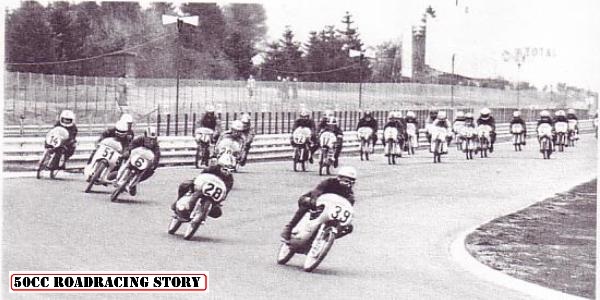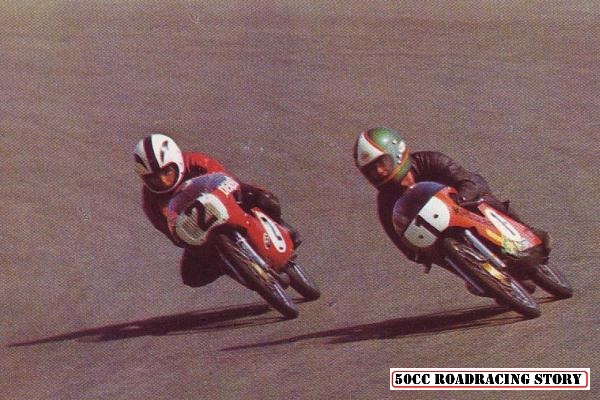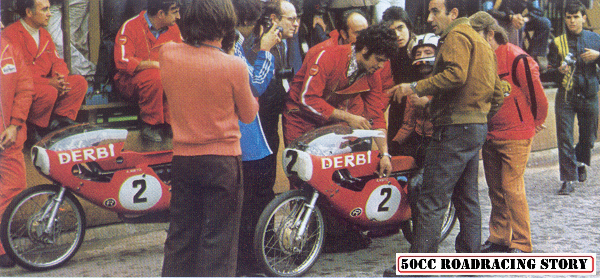1972
The 1972 season started with the German Grand Prix, which was won by Jan de Vries (Van Veen Kreidler). The followers were 2. A. Nieto (Derbi), 3. B. Jansson (Jamathi), 4. H. Bartol (Kreidler), 5. G. Thurow (Kreidler) and 6. J. Bruins (Kreidler).
Next was Italy, with 1. De Vries (Van Veen Kreidler), 2. Nieto (Derbi), 3. Kunz (Kreidler), 4. Buscherini (Malanca), 5. Huberts (Kreidler) and 6. Hummel (Kreidler).
In Yugoslavia Jan de Vries had to retire, but the race was won by compatriot Jan Bruins on his privately tuned Kreidler. Second was again Angel Nieto (Derbi), with 3. Buscherini (Malanca), 4. Kurt Carlsson (Monark), and 5. A. Bernetic (Tomos). No sixth place - those five were the only riders that finished!
Next was the Dutch TT, and as usual the Dutch didn't win there. Results were: 1. A. Nieto (Derbi), 2. J. de Vries (Van Veen Kreidler), 3. H. Bartol (Kreidler), 4. Theo Timmer (Jamathi), 5. G. Thurow (Kreidler) and 6. J. Huberts (Kreidler).
In Belgium, on Francorchamps, it was again Nieto (Derbi) who won ahead of De Vries (Van Veen Kreidler), with 3. Timmer (Jamathi), 4. Bartol (Kreidler), 5. Kunz (Kreidler) and 6. Bruins (Kreidler).
In East Germany, both De Vries (Van Veen Kreidler) leading the race, and Nieto (Derbi) retired, and Theo Timmer (Jamathi) won. Second was Hummel (Kreidler), 3. Buscherini (Malanca), 4. Huberts (Kreidler), 5. L. Rinaudo (Tomos) and 6. A. Toersen (Kreidler).
Sweden was won by Jan de Vries (Van Veen Kreidler), and Angel Nieto (Derbi) retired, which meant that both riders still had a chance on the world title - the last race of the season had to bring, again, the decision! Second was Theo Timmer (Jamathi), and 3. J. Parés (Derbi), 4. Jan Bruins (Kreidler), 5. Teun Ramakers (Kreidler) and 6. Lars Persson (Monark).
The last GP was Spain, and here Nieto (Derbi) was the winner, with De Vries (Van Veen Kreidler) second. Third was K. Andersson (Kreidler), 4. B. Grau (Derbi), 5. J. Bruins (Kreidler) and 6. T. Timmer (Jamathi).
Although Jan de Vries and Angel Nieto had the same amount of points, the world championship was won by Angel Nieto, based on his shorter total time. Third was Theo Timmer (Jamathi), fourth Jan Bruins (Kreidler), fifth O. Buscherini (Malanca) and sixth Harold Bartol (Kreidler).
J.Kortekaas 2006
|
Van Veen Kreidler
The Van Veen Kreidlers were the same machines as used in 1971, with detail improvements. Power was given as between 18 and 20 bhp at 16,000 rpm. Carburettor 25 mm Bing - rather old-fashioned, but they gave the best results, and that's what counts! Ignition was no longer by Bosch, but with a Kröber electronic system with battery.
Interesting was the news, that Van Veen brought out a race kit to be fitted to the Kreidler RS engines with rotating inlet for sale to private riders, with a power output of 15 bhp at 14,800 rpm. The kit consisted of a water-cooled cylinder and head, piston and exhaust system. Furthermore the Belgian rider Van Meulecom got an old Van Veen Kreidler, with a five-speed engine with this kit. |
 |
 |
 |
Derbi
For the 1972 the same hold as for the Van Veen Kreidler: same machines as used the previous year with detail modifications
|
|
Jamathi
The Jamathi got a totally new engine, now with a horizontal cylinder. The word "lek" written on the cylinder means that this was a leaky one!). As can be clearly seen from the picture, the engine parts were not cast but machined from the full material.
|
 |
 |
For 1972 a new monocoque frame was developed, the "tank" is just something to lie down on! The bike still got only one Koni rear shock absorber, although with the low slung exhaust this was not really needed any longer. |
Monark
A newcomer on the scene was Swedish Monark, which brought out a 50 cc racer, using a German Sachs engine in their own frame. The engine was extensively modified, with a new crankshaft, and the bore and stroke changed from the original 38 x 44 mm to 39.6 x 39.6 mm. The inlet system was changed to rotating inlet, carburation was by a Gardner carburettor with Amal float chamber. The exhaust faced to the rear, MZ fashion. Claimed power output for the air-cooled engine was 15 bhp. Ignition Kröber electronic, fed by a 12 V battery. |
  |
 |
The frame was Monark, with Marzocchi front forks and the well known 180 mm Fontana front brake, Koni shock absorbers at the rear.
|



















